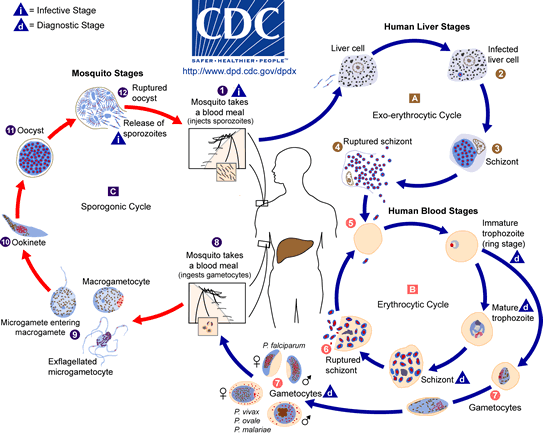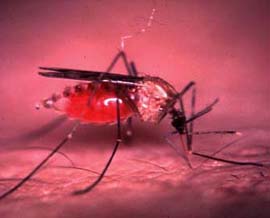Quick Facts
|
Malaria is caused by a parasite called Plasmodium, which is transmitted via the bites of infected mosquitoes. Symptoms of malaria show up typically around two weeks after infection and include vomiting, fever and headache. Severe disease frequently progresses to coma and death. Prompt treatment with medications is critical. A major challenge to the control of malaria is increasing resistance to most available drugs. New artemisinin-based combination therapy regimens are generally highly effective, offering hope for improved disease control, but resistance to artemisinins may now be emerging, and resistance to partner drugs in the combination regimens is already a problem. Thus, there is clearly a need for new antimalarial drugs, ideally directed against novel targets. These drugs may play important roles both in the treatment of malaria and in the prevention of disease in high-risk groups.
What is it?
When an infected mosquito pierces a person's skin to take a blood meal, parasites (sporozoites) in the mosquito's saliva enter the bloodstream and migrate to the liver and infect liver cells (hepatocytes). The parasite multiplies for several days, during which time the individual shows no symptoms. After approximately 2 weeks, the infected liver cells rupture and release parasites (now merozoites), which then go on to infect red blood cells. The parasites enter a cycle of multiplication in the red blood cells, eventual rupture of infected cells to release parasites which then infect new blood cells. The most common and deadly form of malaria causes the blood cells to stick to the walls of small blood vessels by causing the blood cells to display adhesive proteins on the cell surface. Small blood vessels can eventually be blocked by the attachment of large numbers of these cells, leading to tissue oxygen deprivation, hemorrhaging, coma, and death.

Where does it occur?
 Malaria is widespread in tropical and subtropical regions, including the Americas, Asia, and Africa. Each year, there are approximately 250 million cases of malaria, killing over one million people. Ninety percent of malaria-related deaths occur in sub-Saharan Africa, where 1 out of 5 young children die from this disease. While not limited to the poor, malaria impacts the poor disproportionately, due to lack of access to preventative measures and treatment. The economic loss in endemic countries is significant due in part to effects on worker productivity, early mortality and high medical costs.
Malaria is widespread in tropical and subtropical regions, including the Americas, Asia, and Africa. Each year, there are approximately 250 million cases of malaria, killing over one million people. Ninety percent of malaria-related deaths occur in sub-Saharan Africa, where 1 out of 5 young children die from this disease. While not limited to the poor, malaria impacts the poor disproportionately, due to lack of access to preventative measures and treatment. The economic loss in endemic countries is significant due in part to effects on worker productivity, early mortality and high medical costs.

 Malaria is transmitted during blood meals taken by infected mosquitos. Credit: WHO/TDR
Malaria is transmitted during blood meals taken by infected mosquitos. Credit: WHO/TDR